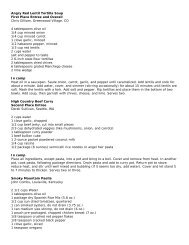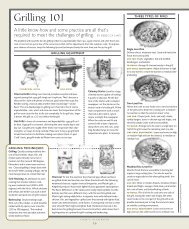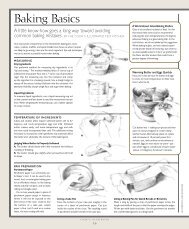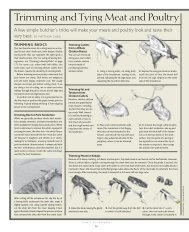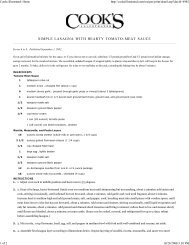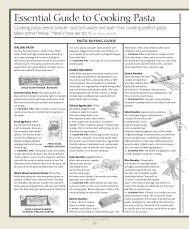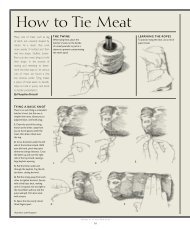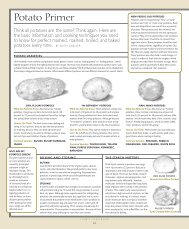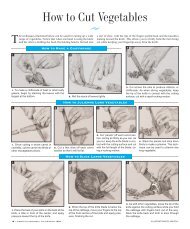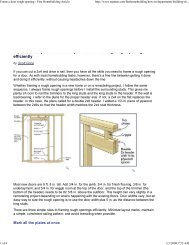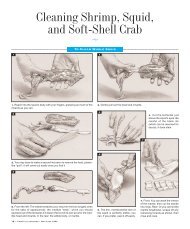Illustrated Guide to Kitchen Knives.pdf - Tru-Burn
Illustrated Guide to Kitchen Knives.pdf - Tru-Burn
Illustrated Guide to Kitchen Knives.pdf - Tru-Burn
Create successful ePaper yourself
Turn your PDF publications into a flip-book with our unique Google optimized e-Paper software.
KEEPING K NIVES SHARP<br />
A knife loses its sharpness when the fine tip of the cutting edge gets knocked slightly<br />
out of alignment, which can happen any time the blade makes contact with food<br />
or a cutting board. The knife may “act dull” even though the edge is still quite sharp<br />
—it’s just pointed in the wrong direction. This can happen very quickly if you are doing<br />
a lot of heavy cutting work, but the edge can be just as quickly res<strong>to</strong>red by using<br />
a sharpening steel, which realigns the edge and removes slight irregularities.<br />
Two ways <strong>to</strong> protect your knife’s edge are <strong>to</strong> avoid hard cutting surfaces such as<br />
glass or acrylic (stick <strong>to</strong> wood and plastic cutting boards) and <strong>to</strong> keep them out of<br />
the dishwasher, where getting knocked around might damage their edge.<br />
Is It Sharp?<br />
To determine if your knife needs <strong>to</strong> be<br />
sharpened, put it <strong>to</strong> the paper test.<br />
1. Hold a folded, but not creased, sheet<br />
of newspaper by one end.<br />
2. Lay the blade against the <strong>to</strong>p edge at<br />
an angle and slice outward. If the knife<br />
fails <strong>to</strong> slice cleanly, try steeling it. If it still<br />
fails, it needs sharpening.<br />
Choosing—and using—‚a Steel<br />
You should steel your knives regularly, before each use if possible, but sharpen them<br />
only when necessary. Traditional steels are lightly grooved, magnetized iron rods,<br />
but we prefer the newer diamond steels—hollow oval tubes coated with diamond<br />
dust. These grind trace amounts of metal from the knife with each swipe, partially<br />
sharpening the blade while straightening it and extending the period between<br />
sharpenings. However, keep in mind that steeling will only realign a fairly sharp<br />
blade; a dull knife has <strong>to</strong> be sharpened (see below).<br />
1. Hold the steel perpendicular <strong>to</strong> the work surface,<br />
with the tip resting on a cutting board.<br />
2. Place the heel of the blade against the steel, with the<br />
blade at a 20-degree angle away from it.<br />
3. With a locked wrist and light pressure, slide<br />
the blade down the length of the steel in a sweeping<br />
motion, pulling the back of the blade <strong>to</strong>ward you<br />
so that the entire length of the blade comes in<br />
contact with the steel.<br />
4. Repeat the motion on the other side of<br />
the blade. Four or five strokes per side should<br />
realign the edge.<br />
Sharpening<br />
There are two options for grinding a new edge on a knife at home:<br />
1. Sharpening s<strong>to</strong>ne. This method is effective but takes some practice, and it’s<br />
more work than many home cooks want <strong>to</strong> do. It involves a double-sided sharpening<br />
s<strong>to</strong>ne, some elbow grease, and about 15 minutes per blade. (For step-by-step<br />
instructions, see Cook’s Extra, below at right.)<br />
2. Knife sharpener. An electric home sharpener can res<strong>to</strong>re the edge of even a<br />
seriously neglected blade, provided you buy one with a coarse regrinding wheel,<br />
such as our favorite, the Chef’sChoice<br />
110 ($80). Some less expensive models<br />
feature only medium- and fine-grade slots,<br />
good for perking up a slightly dull blade but<br />
unable <strong>to</strong> grind a completely new edge.<br />
These machines do remove a certain amount<br />
of metal from the blade with each use, so<br />
use them no more than necessary.<br />
B A S I C K N I F E T E CH N I Q U E S<br />
Two Basic Grips<br />
Handle Grip<br />
With the handle grip, the thumb rests<br />
on the side of the handle opposite the<br />
index finger. This grip is the favored by<br />
test cooks with smaller hands. For those<br />
who work long hours with a knife, it also<br />
causes fewer calluses.<br />
Safe Slicing with a ‘Guiding Hand’<br />
By properly positioning the hand that is not holding the knife, you can prevent<br />
slippage, control the size of the cut, and<br />
protect your fingers.<br />
In this “bear claw” position, the fingertips<br />
are curled back away from the knife <strong>to</strong> hold<br />
the food in place, while the knuckles rest<br />
against the side of the blade, providing<br />
guidance with no danger of being cut.<br />
To cut multiple slices, use the curvature<br />
of the blade <strong>to</strong> guide the knife through a<br />
series of smooth cutting strokes. Some part<br />
of the blade should remain in contact with<br />
the cutting board at all times. During the<br />
upward motion, reposition the guiding<br />
hand <strong>to</strong> set up the next slice.<br />
Chopping and Mincing<br />
This fast, continuous motion makes<br />
quick work of fresh herbs, onions, and<br />
the like. It begins with the handle held<br />
high and the knife tip on the cutting<br />
board, held gently in place with the<br />
guiding hand. The front half of the blade<br />
remains in contact with the cutting<br />
board at all times.<br />
cook’s<br />
ex tra<br />
Blade Grip<br />
Go <strong>to</strong> www.cooksillustrated.com<br />
• Key in code 70613 for our <strong>Illustrated</strong><br />
<strong>Guide</strong> <strong>to</strong> Sharpening <strong>Knives</strong>.<br />
• Available until January 1, 2007.<br />
Cooks with larger hands often prefer<br />
the blade grip, in which the thumb and<br />
index finger actually grip the heel of<br />
the blade. While this grip requires a bit<br />
more hand strength, it also provides<br />
more control over the tip of the blade.<br />
Careful Carving<br />
The key <strong>to</strong> smooth, even cuts<br />
is a long stroke with very mild<br />
downward pressure. Let the<br />
knife do the work, and avoid<br />
short, sawing strokes, which<br />
yield ragged slices.<br />
j u l y & a u g u s t 2 0 0 6<br />
17





